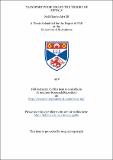Files in this item
Transport problems in the theory of metals
Item metadata
| dc.contributor.advisor | Dingle, R. B. | |
| dc.contributor.author | McGill, Neil Charles | |
| dc.coverage.spatial | 190 p. | en_US |
| dc.date.accessioned | 2018-06-26T09:41:09Z | |
| dc.date.available | 2018-06-26T09:41:09Z | |
| dc.date.issued | 1972 | |
| dc.identifier.uri | https://hdl.handle.net/10023/14588 | |
| dc.description.abstract | Of all common substances, metals conduct heat and electricity to the greatest extent. They also exhibit very readily a range of more complicated phenomena – the galvanomagnetic, thermomagnetic and thermoelectric effects – which results when an electric field, a thermal gradient and a magnetic field are combined in various ways. Any theory of the metallic state, therefore, must explain why metals should demonstrate these properties as well as they do, and account for the variation of the physical quantities in question with temperature, electric field, atomic structure and so on. It is now well established that the simplest metals are characterised by an energy band structure in which the topmost occupied band is half full, so making it easy to impart extra energy to those electrons lying at or just below the Fermi level. The electrons in this band are loosely bound to the atomic cores, and can readily move through the material. When an external electric field is applied, the average motion of such electrons in the direction of the field constitutes an electric current, while a thermal current results (in the presence of a thermal gradient) from the diffusion of electrons from hot to cold areas. Similar qualitative explanations may be furnished for the more complicated thermal, electric and magnetic effects. Quantitatively, the key to the calculation of the transport coefficients – and the electrical and thermal conductivities, the Hall coefficient, and so on – lies in the evaluation of the distribution function 𝛽 (I, k, t) which describes how to the electrons are distributed in (I, k) space at any time t. This function is found by solving the Boltzmann transport equation, the mathematical expression of the statement that any change in 𝛽 with time is the sum of three contributions, one for each possible cause: diffusion, collisions, and the action of external fields. Even after simplifying assumptions have been made about the lattice through which the electrons move, the Boltzmann equation is, in its most general form, a complicated integral equation, the complezity stemming partly from the different types of electron collision which must all be represented: collisions with thermal vibrations of the lattive, with impurities, with other displaced atoms, with boundary surfaces, and so on. In practice relief is usually gained by considering only one or perhaps two of these types of collision at a time, assuming conditions which make these dominant. In the first problem to be considered here, attention is restricted mainly to the case where electrons are scattered by thermal vibrations of the lattice; in the second, the emphasis is on collisions which electrons make with the metal surface. | en_US |
| dc.language.iso | en | en_US |
| dc.publisher | University of St Andrews | |
| dc.subject.lcc | QC176.2M4 | |
| dc.subject.lcsh | Solid-state physics | en |
| dc.title | Transport problems in the theory of metals | en_US |
| dc.type | Thesis | en_US |
| dc.contributor.sponsor | Carnegie Trust for the Universities of Scotland | en_US |
| dc.type.qualificationlevel | Doctoral | en_US |
| dc.type.qualificationname | PhD Doctor of Philosophy | en_US |
| dc.publisher.institution | The University of St Andrews | en_US |
This item appears in the following Collection(s)
Items in the St Andrews Research Repository are protected by copyright, with all rights reserved, unless otherwise indicated.

